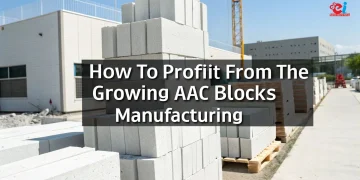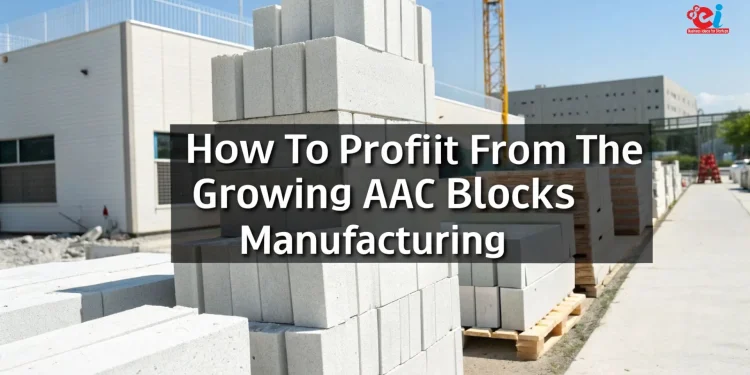Introduction
In recent years, the building industry has started to favor newer, greener materials, pushing the spotlight on Autoclaved Aerated Concrete (AAC) blocks. These AAC Blocks Manufacturing have won over contractors, architects, and engineers all over the world thanks to their lightweight lift, excellent insulation, fire safety, and eco-friendly benefits. Bit by bit, they are replacing the conventional red brick. For entrepreneurs and new businesses in the production world, this shift lightens the door to enter a booming sector that the market wants and that sustainable development goals call for.
India, already one of the planet’s largest construction hubs, is in the middle of sweeping urban change. This change is fueled by a hunger for housing, road and rail projects, and programs backed by the government, like Housing for All and the Smart Cities Mission. With their blend of lower cost and greener production, AAC blocks slip smoothly into the plan. This article pulls back the curtain on the AAC block manufacturing venture, examining market possibilities, the drivers of demand, the making process, and ways for newcomers to grab bigger wins down the road.
The Market Potential of AAC Blocks
The AAC blocks manufacturing has surged over the last ten years, fueled by the boom in demand for cutting-edge building materials. Worldwide, the AAC market forecasts point to $31 billion in sales by 2030, expanding at close to 7% a year. In India, the boom is even hotter. The sector is set for double-digit growth as the country’s cities grow and industry heats up.
By 2022, India’s AAC block market was valued at about $8.2 billion, and it’s now on track to hit $18 billion by 2030—a growth rate of 10% to 12% year-on-year. People are steering towards green building methods, the supply of clay for traditional bricks is shrinking, and new laws urging energy-saving construction are pushing the leap towards AAC blocks, making the future look bright for the industry.
To put it simply, here’s a quick look at how the AAC block market in India is predicted to grow:
| Year | Market Size (USD Billion) | Growth Rate (%) | Key Drivers |
| 2022 | 8.2 | – | Baseline market |
| 2023 | 9.1 | 11% | Rising real estate activity |
| 2024 | 10.2 | 12% | Adoption of green materials |
| 2025 | 11.5 | 13% | Affordable housing demand |
| 2026 | 13.0 | 13% | Government incentives |
| 2027 | 14.8 | 14% | Smart city projects |
| 2030 | 18.0 | 10-12% CAGR | Large-scale infrastructure initiatives |
These numbers show a clear upward slope, reminding us how closely the AAC block market is tied to the construction sector. For new companies, the key is to ride this wave by combining innovation with sustainable methods.

Check out our Books on Cement, Asbestos, Ceramics, Bricks, Limestone and Construction Materials Manufacturing Technology
Why Builders Prefer AAC Blocks Over Clay Bricks
AAC blocks are winning the popularity contest against traditional clay bricks for a bunch of good reasons. First, these blocks are light, which cuts down the amount of steel and cement needed in a building’s frame. Second, they provide great thermal insulation, so homes stay cooler in summer and warmer in winter without extra energy costs for heating and cooling. That means smaller power bills and a smaller carbon footprint by using energy-efficient materials.
Another major plus is how precise and uniform these blocks are. While regular bricks can vary widely, AAC blocks are cut with advanced tech that guarantees the same size and a silky edge. Builders save time because the blocks fit together quickly, need less mortar, and rarely require extra plaster. They resist fire and absorb sound well, too, which is why both houses and offices are turning to them.
As climate worries grow, the green edge of AAC blocks matters more than ever. They contain fly ash, a by-product of burning coal to make electricity, plus lime, cement, gypsum, and a puff of aluminum powder. By reusing this waste, the blocks help keep landfills smaller. Regulators are pushing for greener materials, and AAC blocks are already a ready-made answer.
Related: Start an AAC Block Plant in India
Demand Drivers and Growth Factors
The AAC block market is booming for a mix of economic and industry reasons. More people want homes, especially in crowded cities and nearby smaller towns, and that spike is driving the need for speedier, budget-friendly building methods. Because they are light, handle easily, and install quickly, AAC blocks are stepping in to fill that gap.
Government rules aimed at creating affordable homes and smarter infrastructure keep driving growth. The Pradhan Mantri Awas Yojana (PMAY), for instance, is speeding up low-cost housing projects, and AAC blocks manufacturing is often chosen because they are cheap and keep buildings cooler. At the same time, the boom in commercial real estate— new malls, schools, hospitals, and office blocks— is creating even more need for these blocks.
Metro rail systems, fancy new airports, and the concept of smart cities are also pushing more AAC blocks into use. Growing interest in green buildings and systems like LEED (Leadership in Energy and Environmental Design) nudges builders to pick AAC blocks instead of more traditional products.
Steps in the AAC Block-Making Process
Making AAC blocks calls for a blend of chemical reactions and smart engineering. While plant size changes, the main steps stay consistent.
Raw Material Prep
The main stuff used is fly ash (or sand), cement, lime, gypsum, and a small amount of aluminum powder. Fly ash, or sand, is milled to a fine powder to keep each block at the same high standard of quality.
Manufacturing Process for AAC Blocks
Mixing and Dosing
Proportions are key here. The ground raw mix goes into a hopper with lime, cement, gypsum, and a small dose of aluminum powder. When aluminum meets lime and a splash of water, a quick, bubbling reaction happens. The aluminum releases hydrogen, making a host of tiny bubbles that turn the mix into a super-light paste ready for casting.
Casting and Pre-Curing
Next, the slurry is dumped into adjustable steel molds. The tiny bubbles expand. The paste feels firmer in just 30 minutes, gaining enough strength so that it won’t crumble when it’s sliced.
Cutting
The molds roll out a white, pancake-thick sheet. Armed with diamond-bladed wire, a robotic cutter slices it into slabs, then into precise, block-perfect cubes. Thanks to set laser guides, a 1mm tolerance is the norm.
Autoclaving
The freshly cut cubes ride automatic cranes into the autoclave, which resembles an oversize pressure cooker. With steam at 180ºC and 12 bars of pressure, the blocks steam for about 12 hours. When the cycle finishes, strength is sky-high, and insulation for heat and noise is optimized.
Packing and Dispatch
Blocks cool in a foyer chamber before the packing line. Automated stackers layer cubes onto wooden or steel pallets, then a stretch-wrapper hugs each load. The blocks are now ready for flatbed trucks, ready to reach job sites in hours.
This quick line seals a green deal. AAC blocks are 80% recycled material and don’t require the burning of limestone, cutting CO₂. Advanced sensors and batch control software keep the line humming, cutting waste and boosting productivity, letting builders put a quality, low-weight block in place every single time.
Related: A Successful Business Idea for AAC Blocks and Panels
Challenges in the Industry
Although it is a promising sector, AAC blocks manufacturing is not without its growing pains. One major hurdle is the limited knowledge among smaller builders and rural contractors. While major developers and big city firms quickly embrace the technology, many local players still default to red bricks out of habit and misinformation. Unless the benefits—like reduced load on structures and energy savings—are well understood, adoption will stall.
Another difficulty is logistics. AAC blocks manufacturing are lightweight but very porous, meaning they can break or crumble if not handled with care. This creates complexities in loading, stacking, and on-site storage, leading to costs that can trip up smaller orders. Compounding the problem are the traditional brick kilns that, even with their heavy carbon footprints, cling to market share because their supply routes are entrenched and their upfront pricing appears more attractive, despite the long-term savings AAC blocks offer.
To break through the market barriers, startups will need to run targeted awareness campaigns, build more reliable distribution networks, and form alliances with leading real estate firms. Only then can the sector turn its promise into widespread practice.
Future Outlook of AAC Blocks Manufacturing
The future of AAC blocks manufacturing looks promising, with strong alignment between market demand and sustainability trends. Over the next decade, urbanization in India is expected to add nearly 400 million new urban residents, creating unprecedented demand for housing and infrastructure. AAC blocks, with their cost savings and ecological benefits, are poised to capture a significant share of this market.
Technological advancements will further enhance product quality and reduce production costs, making AAC blocks even more competitive. With green construction becoming a global standard, AAC blocks manufacturing are likely to see rising demand not just in domestic markets but also in exports, particularly to neighboring countries in South Asia, Africa, and the Middle East.
Role of NIIR Project Consultancy Services (NPCS)
For entrepreneurs and startups aiming to enter AAC blocks manufacturing, professional guidance can make all the difference. NIIR Project Consultancy Services (NPCS) prepares Market Survey cum Detailed Techno Economic Feasibility Reports that provide entrepreneurs with actionable insights. Their reports cover crucial aspects such as the manufacturing process, raw materials, plant layout, and financials. NPCS helps entrepreneurs assess the feasibility of setting up new industries, ensuring they have a clear roadmap before making strategic decisions.
Find Best Idea for Yourself With our Startup Selector Tool
Conclusion
AAC block manufacturing represents a high-growth opportunity for entrepreneurs who want to enter the construction materials industry. With rising demand for sustainable, cost-effective, and efficient building solutions, AAC blocks are rapidly transforming into the material of choice for developers and builders. The manufacturing process, though technologically intensive, is straightforward and scalable, offering startups the chance to establish competitive businesses in both domestic and international markets.
As India’s real estate and infrastructure sectors continue to expand, the adoption of AAC blocks will grow in tandem, making this one of the most promising industrial ventures of the coming decade. By leveraging professional consultancy services and modern technology, entrepreneurs can position themselves at the forefront of a sector that combines profitability with sustainability.


















